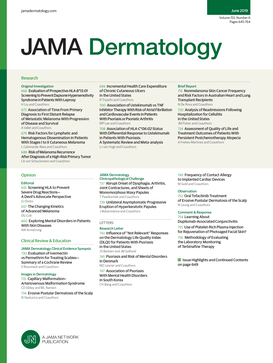Al-Janabi A, Alabas OA, Yiu ZZN, et al. JAMA Dermatol. Published online December 06, 2023. doi:10.1001/jamadermatol.2023.4846
Key Points
Question What factors are associated with paradoxical eczema occurring in patients with psoriasis treated with biologics?
Findings In this cohort study of 24 997 biologic exposures in 13 699 patients with psoriasis, risk of paradoxical eczema was lowest in patients receiving interleukin 23 inhibitors compared with other biologic classes. Increasing age, history of atopic dermatitis, and history of hay fever were associated with higher risk of paradoxical eczema; risk was lower in males.
Meaning The findings suggest that interleukin 23 inhibitors could be considered in patients with psoriasis with factors associated with paradoxical eczema.
Abstract
Importance Biologics used for plaque psoriasis have been reported to be associated with an atopic dermatitis (AD) phenotype, or paradoxical eczema, in some patients. The risk factors for this are unknown.
Objective To explore risk of paradoxical eczema by biologic class and identify factors associated with paradoxical eczema.
Design, Setting, and Participants This prospective cohort study used data from the British Association of Dermatologists Biologics and Immunomodulators Register for adults treated with biologics for plaque psoriasis who were seen at multicenter dermatology clinics in the UK and Ireland. Included participants were registered and had 1 or more follow-up visits between September 2007 and December 2022.
Exposures Duration of exposure to tumor necrosis factor (TNF) inhibitors, interleukin (IL) 17 inhibitors, IL-12/23 inhibitors, or IL-23 inhibitors until paradoxical eczema onset, treatment discontinuation, last follow-up, or death.
Main Outcomes and Measures Incidence rates of paradoxical eczema, paradoxical eczema risk by biologic class, and the association of demographic and clinical variables with risk of paradoxical eczema were assessed using propensity score–weighted Cox proportional hazards regression models.
Results Of 56 553 drug exposures considered, 24 997 from 13 699 participants were included. The 24 997 included exposures (median age, 46 years [IQR, 36-55 years]; 57% male) accrued a total exposure time of 81 441 patient-years. A total of 273 exposures (1%) were associated with paradoxical eczema. The adjusted incidence rates were 1.22 per 100 000 person-years for IL-17 inhibitors, 0.94 per 100 000 person-years for TNF inhibitors, 0.80 per 100 000 person-years for IL-12/23 inhibitors, and 0.56 per 100 000 person-years for IL-23 inhibitors. Compared with TNF inhibitors, IL-23 inhibitors were associated with a lower risk of paradoxical eczema (hazard ratio [HR], 0.39; 95% CI, 0.19-0.81), and there was no association of IL-17 inhibitors (HR, 1.03; 95% CI, 0.74-1.42) or IL-12/23 inhibitors (HR, 0.87; 95% CI, 0.66-1.16) with risk of paradoxical eczema. Increasing age (HR, 1.02 per year; 95% CI, 1.01-1.03) and history of AD (HR, 12.40; 95% CI, 6.97-22.06) or hay fever (HR, 3.78; 95% CI, 1.49-9.53) were associated with higher risk of paradoxical eczema. There was a lower risk in males (HR, 0.60; 95% CI, 0.45-0.78).
Conclusions and Relevance In this study, in biologic-treated patients with psoriasis, paradoxical eczema risk was lowest in patients receiving IL-23 inhibitors. Increasing age, female sex, and history of AD or hay fever were associated with higher risk of paradoxical eczema. The overall incidence of paradoxical eczema was low. Further study is needed to replicate these findings.


No comments:
Post a Comment